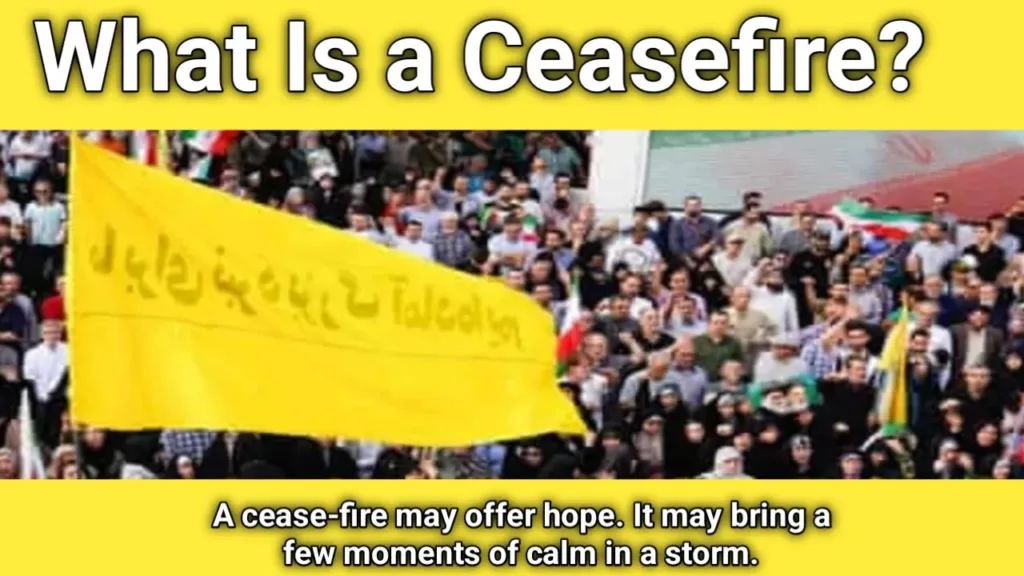
In the middle of a war, when the sound of gunfire pauses and the skies fall silent—what does that really mean? This moment is often the result of a cease-fire, a temporary agreement between warring sides to stop fighting in a particular area for a set period of time.
Sometimes, a cease-fire is declared by one side (unilaterally), but in many cases, it’s negotiated between both parties involved in the conflict. While it may offer a brief window of peace, a cease-fire is not the same as the end of war. It’s just a pause, not a resolution.
Cease-Fire vs. Armistice: What’s the Difference?
People often confuse the terms cease-fire and armistice, and while they’re similar, they’re not identical.
- A cease-fire is a short-term agreement to stop fighting—either in a small area or across a whole battlefield.
- An armistice is usually broader in scope. It’s a military agreement to suspend fighting indefinitely, often across the entire theater of war.
Neither of these actually ends a war legally. They are temporary halts in combat, not permanent peace. That’s what makes them different from peace treaties, which formally and legally declare the end of a war.
Why Do Cease-Fires Happen?
While it may seem like cease-fires are designed to help civilians or allow aid to reach war-torn areas, that’s not always the case.
In truth, most cease-fires are strategic military decisions. They may be used to:
- Regroup troops
- Assess the strength and leadership of the enemy
- Open space for negotiations
- Test whether the opposing side can actually control its forces
So, even when fighting stops, there may be underlying tactical reasons driving the decision. It’s less about peace and more about strategy.
Also Read:- I Am Malala: A Voice That Rose Against Bullets and Silence
Cease-Fires and Humanitarian Aid: A Double-Edged Sword
International humanitarian law does support the idea that fighting should stop temporarily, if possible, to allow the wounded and sick to be rescued or transported. Article 15 of the Geneva Convention I says that, when circumstances allow, a pause in fighting should be arranged so that help can reach those in need.
But in real-world war zones, things aren’t that simple.
Sometimes, armed groups exploit humanitarian cease-fires for their own gain. They might:
- Use the cease-fire as a political bargaining tool
- Test how much control the enemy has over its soldiers
- Pretend to allow aid in, while using the time to rearm or reposition
This puts aid organizations in a very tough spot. They need to carefully weigh the risks before stepping into a war zone under the protection of a cease-fire.
Aid Should Never Be a Bargaining Chip
One key principle must always remain firm: humanitarian help should never be used as leverage in a conflict. Relief organizations provide support based on need—not on the outcome of political deals or military pressure.
Unfortunately, in reality, some parties to conflict try to make aid conditional—only allowing it if certain political or military goals are met. This is against humanitarian principles, and it places both civilians and aid workers in danger.
Also Read:- The Story Of Karbala
Final Thoughts: Cease-Fires Are Not Peace
A cease-fire may offer hope. It may bring a few moments of calm in a storm. But it’s important to understand what it truly is—a temporary pause, not a resolution.
It doesn’t mean the war is over. It doesn’t mean justice has been served. And it doesn’t guarantee that the fighting won’t start again tomorrow.
Still, even temporary pauses in conflict can save lives and open the door to real peace—if they are used wisely, fairly, and with genuine intent.
✅ Summary in Simple Words:
- Cease-fire: A temporary stop in fighting, often for military reasons.
- Armistice: A broader, usually longer pause in war.
- Not peace: Neither ends a war legally.
- Humanitarian aid: Should never be used as a political tool.
- Aid workers: Must be cautious—some parties use cease-fires for strategic gain.
